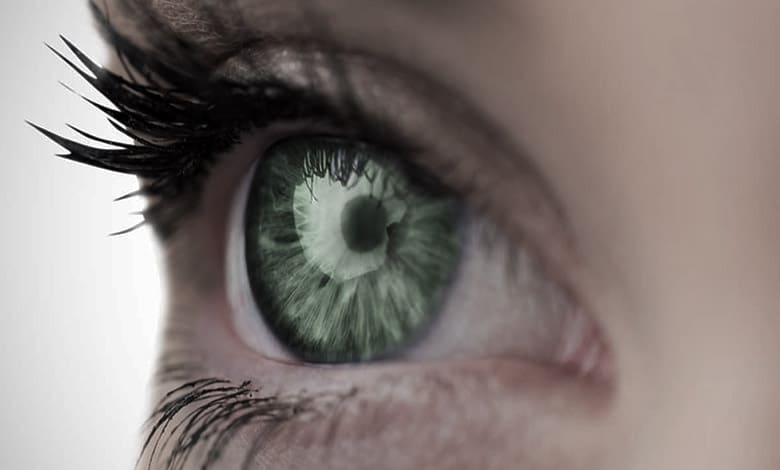
The color of the eyes is genetic, and the essential gene is OCA2. It can change depending on mood and other factors. Most genes associated with eye color are involved in the production, storage, and transfer of pigment called melanin. Eye color is directly related to the quality and quantity of melanin in the iris. So people with brown eyes have a lot of melanin, and those with blue eyes have less melanin.
Anthropologists use an official scale to classify people’s eye colors worldwide. How is eye color inherited, anyway? Traits come partly from genes: little bits of DNA passed down from parents.
Eye color facts
About 50% of people have brown eyes and different shades of brown. All those eyes look different in combination with other features of a person. Some people’s whites are slightly less contrasted, less white, and bright. But they’re still white. Every person has a different contrast between their pupil and iris with the whites.
So the darker the color is, the more conscious there is with the whites of the eyes. The lighter the eyes, the last contrasted they will look with the whites. Finally, they look glossy, shiny, and sometimes transparent, like the light of the eyes look the more transparent they look. It seems like the light goes right there to the middle of the head, like through the tunnel. Here are 10 eye colors that explain the causes and facts.
1) Different-colored eyes
Eyes of uncommon colors called attention, but it would be even rarer to see a person with eyes of different colors. This phenomenon is known as heterochromia in the iris.
Have you ever looked closely at Mila Kunis or Kate Bosworth’s eyes? If so, you might have noticed that their eyes differ in color. It’s caused by heterochromia. It can appear in 3 forms:
- Complete: When one iris is entirely different than the other.
- Segmental: Only a part of an iris has a different color.
- Central: The iris has a different color near the border of the pupil. In cartoons, having two different eyes is usually a sign of insanity or split personality. There’s no reason to believe cartoons, though. Heterochromia is a harmless disorder that does not influence someone’s sight or character. It also appears among animals.
- It’s so uncommon that only 11 in every 1000 people well in the United States suffer from this condition.
There are two kinds of heterochromia: the essential and the acquired. The first one is presented since the person is born, which means genetic. The second one happens when one of the colors changes for an external factor, such as the contact of the iris with iron glaucoma or optic pathologies. Heterochromia only affects one eye and doesn’t put the person’s life in danger.
2) Red eyes
In real life, red-eye color occurs among people with severe albinism forms and results from extremely low quantities of melanin. Blood vessels show through, creating an impression of the red color.

- Albinism is associated with many vision defects: photophobia, squint, myopia, amblyopia, or nystagmus, to name a few of them.
Approximately 0.3% of the population has an iris of this color. Principally, the albino’s white skin highlights the red eyes. Besides red eyes, people with albinism tend to have pink or violet eyes. It depends on the composition of the iris. This is because they grow without melamine, and the blood vessels from the ocular Glover are reflected when the light goes through their eyes.
3) Violet eyes
Violet eyes are so rare that they seem like a myth. These eyes exist, and they’re a result of a mutation. This eye color is extremely rare, and it looks unique.
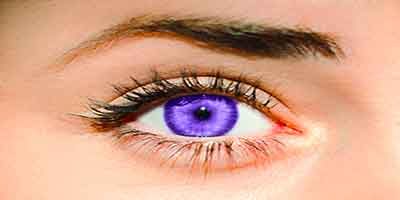
- Violet eyes occur from a mixing lack of pigment and red from light reflecting off blood vessels within the eyes.
- This eye color is typically found in people with albinism.
4) Gray eyes
Gray eyes are most common in Northern, Western, and Central Europe. Blue and gray eyes are similar genetically. One possible explanation is the larger deposit of collagen in the stroma in the case of gray eyes. That affects how the light is reflected and, consequently, how the color is perceived.
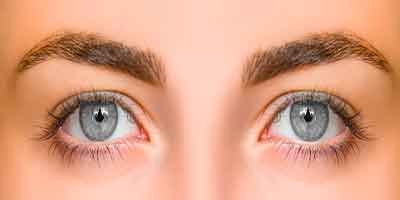
- Gray-eyed people are considered strong, imaginative, and flexible, making them great leaders.
- All people with light-colored eyes and those with gray should take special care when exposing their eyes to sunlight.
5) Blue eyes
Scientists from the University of Copenhagen revealed that blue eyes developed due to a genetic mutation in a single European individual 6,000 to 10,000 years ago. That would mean that all the blue-eyed people have the same ancestor.
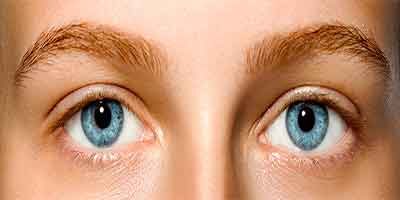
- Blue-eyed people have a higher pain and alcohol tolerance than those with brown eyes.
- Although blue eyes are seen as attractive, people with that feature are often more competitive or egotistical.
- They are associated both with attractiveness and cruelty.
- Blue eyes contain less melanin and are more UV and blue-light-sensitive.
People with blue eyes should be more careful with their exposure to sunlight. They should pay more attention to protecting their eyes to avoid ocular problems. People with light-colored eyes are usually also pale-skinned. It means that they are often at a higher risk of skin cancers.
6) Green eyes
Green eyes have less melanin than brown eyes but a little more melanin than blue eyes. About 2% of the human population has green eye color. This eye color is more common among women than men.
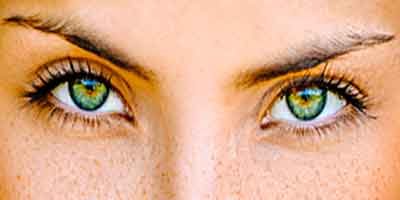
- Green-eyed people are considered more attractive, creative, mysterious, and passionate.
- They are most common in Northern, Western, and Central Europe.
- About 29% of Edinburgh, the capital of Scotland, residents have green eyes.
It’s also associated with red hair, another rare feature of appearance. Maybe that’s why green-eyed and red-haired women are considered so attractive.
7) Amber eyes
Amber eyes are one of the rarest eye colors in the world. Only 0.01% of the human population has amber eyes. That eye color is common among animals, such as cats, owls, eagles, or wolves. That’s why amber eyes are sometimes called “wolf eyes.”
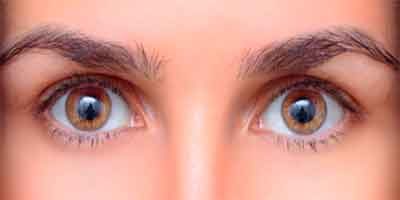
- The color might be confused with hazel, but amber eyes are a solid gold hue. It doesn’t contain other colors.
- The hue is caused by lipofuscin, a yellowish pigment of the iris.
- The color is a result of a series of mutations.
8) Hazel eyes
People with hazel eyes often have multicolored iris. It changes the color with the mood, depending on the light and the surroundings. These eyes are still a bit of a mystery, even when defining the color.
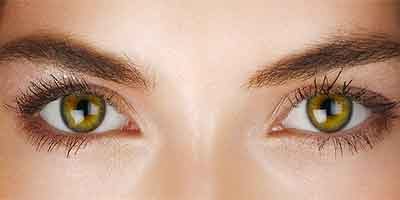
- It’s a blend of various colors rather than a true color itself, which doesn’t make it any less appealing.
- About 74% of hazel eyes have a brown ring around the pupil.
- People with that eye color are told to be unique and mysterious.
- Due to a moderate amount of melanin, their personalities are considered balanced.
Some celebrities have hazel eyes: David Beckham, Penélope Cruz, Jessica Alba, and Ben Affleck. They’re all good-looking, and their unique eyes make them even more attractive. According to Dr. Matthew Leach of the University of South Australia, the color might be caused by liver imbalance. It could make people with hazel eyes more vulnerable to digestive problems.
9) Black eyes
Black eyes are uncommon. Approximately 1% of the population has them. It’s frequently found in African Asians and indigenous Americans but in less proportion. However, another reason for having black eyes is Aniruddha’s rare condition. It means without an iris, which provokes the absence of an iris in both eyes.
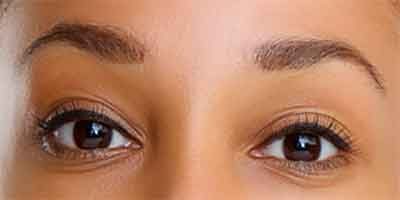
- This condition is uncommon because it only affects 1 in 80,000 people and can be hereditary or appear out of nowhere.
The research shows that people with darker eyes are considered more agreeable. Other studies show that people with black eyes are also better at sports involving hitting targets and drinking less alcohol than people with paler eyes. The darker the eyes get, the more melanin has appeared in the irises. The final eye color sometimes isn’t even fully established until 12.
10) Brown eyes
The most common eye color is brown. This eye color is connected with a high amount of pigment called melanin. It might cause some health benefits. People with brown eyes suffer less from age-related macular degeneration, affecting visual acuity.
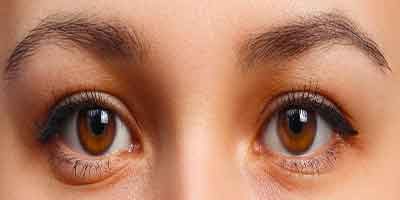
- Women with brown eyes are more likely to be depressed than those with paler eyes.
- Brown eyes people are considered to be more trustworthy.
- Estimates suggest that approximately 55% to 79% of the global population has brown eyes.
University students in the Czech Republic were asked to look at 80 pictures of 19 and 26 years old, 40 men and 40 women. Then they were supposed to rate people’s trustworthiness on a 10-point scale. People with brown eyes were ranked higher than the ones with blue eyes. Even though the correlation appears obvious, it’s not that simple. Facial morphology linked to brown eyes was more important than eye color.
Why are eyes different colors?
Eye colors depend on genetic code or DNA. Many factors affect eye colors.
1. Melanin and aging
Blue eyes result from a low melanin content in the irises causing them to reflect more light versus absorbing it. This phenomenon in the eyes is called the Tyndall effect. It’s like Rayleigh scattering, which makes the sky appear blue. Due to a high melanin content, the outer layer of the iris absorbs more light instead of reflecting it, resulting in that beautiful brown color.
2. Due to an injury or accident
According to the American Academy of Ophthalmology, head or eye trauma can result in heterochromia. It occurs when a person’s eyes have two different colors. Heterochromia also happens when the melanocytes in the eye are shaken after a traumatic event.
This trauma to the melanin in the eye can transform the iris to a lighter or darker shade. When heterochromia is the result of injury, it requires immediate medical attention. Dr. Schwab says it can also be a symptom of an illness such as Horner syndrome, Airy pigment glaucoma, or late-stage diabetes.
3. Mood behavior
The heart rate, breathing, and blood pressure will change when someone experiences happiness, sadness, or anger. Emotions affect your eye color. The pigments in the iris compress apart. It makes it darker or lighter when the size of the pupil changes. The size of pupils depends on their emotional state. The pupils become smaller in bright light and make the irises appear lighter.
4. Raw food diet and detoxing
There’s a theory that the irises’ color and the internal organs’ health are connected. It is called iridology. A natural health and detox expert believes the inner eye is connected to the digestive system.
- Foods that can affect the color of the eyes are olive oil, onions, and nuts.
Eating plenty of fruits and vegetables can change the color of your eyes. Dr. Moore explains that a high concentration of yellow hues signifies many toxins. Every person’s pigment is unique and requires individual analysis. Moore recommends eating spinach to keep the eyes youthful and bright.
5. Laser lightening of the eye color
Eye surgery is very risky and can even result in blindness. Dr. Greg’s innovative and less invasive eye color-correcting laser surgery doesn’t involve much risk. The procedure involves using a laser to destroy melanin cells and the irises, making them appear lighter. So people with brown eyes can have blue or grey eyes. The whole thing only takes 20 seconds to do. The final results become visible within two to four weeks.
The quickest way to change your eye color is to pop in colored or decorative lenses. The American Academy of Ophthalmology says a colored contact lens corrects vision. Decorative lenses are for cosmetic purposes only and don’t correct vision. Dr. Bernard Leper, an FDA optometrist, says that contacts without a prescription may result in corneal ulcers or blindness.
Here are some interesting facts about eye color:
- Eye color is determined by the amount and distribution of melanin, a pigment that gives color to our skin, hair, and eyes. The two primary pigments responsible for eye color are eumelanin (brown to black) and pheomelanin (yellow to red).
- The most common eye color worldwide is brown. Around 55% to 79% of the world’s population is estimated to have brown eyes.
- Blue eyes are relatively rare and are caused by a low concentration of melanin in the iris. They are more commonly found in people of European descent, particularly those from northern Europe.
- Green eyes are also relatively uncommon and result from a combination of low to moderate amounts of melanin in the iris and Rayleigh scattering, which causes the sky to appear blue.
- Hazel eyes mix various colors, including brown, green, and amber. The exact appearance of hazel eyes can vary widely from person to person. Estimates suggest that approximately 5-8% of the world’s population has hazel eyes.
- Gray eyes are a rarer eye color characterized by a lighter shade of blue with a grayish or steely appearance. They have low melanin levels in the front layer of the iris.
- Eye color can change over time, particularly during infancy. Many babies are born with blue or gray eyes, which can darken or change to their permanent color within the first few years of life.
- Genetics influences eye color, with multiple genes determining eye color inheritance. It can be a complex trait with various possible combinations.
- Eye color can also be affected by certain medical conditions or medications. For example, some people with albinism may have very light or even red eyes due to a lack of melanin.
- Although eye color is primarily determined by genetics, it is also influenced by environmental factors, such as lighting conditions and the scattering of light in the iris.
Remember that these facts are generalizations and individual variations in eye color can be quite diverse. Eye color is only one aspect of the beautiful diversity of human appearances.
More Articles:
10 Types Of Dreaming About Someone You Like
References:
Wielgus AR, Sarna T (2005). “Melanin in human irides of different color and age of donors.”
Prota G, Hu DN, Vincensi MR. “Characterization of melanins in human irides and cultured uveal melanocytes from eyes of different colors.”
Fox, Denis Llewellyn. Biochromy: Natural Coloration of Living Things. University of California Press.
Huiqiong Wang; Lin, S.; Xiaopei Liu; Sing Bing Kang (2005). “Separating reflections in human iris images for illumination estimation.” Tenth IEEE International Conference on Computer Vision (ICCV’05) Volume 1.
Table of Contents

